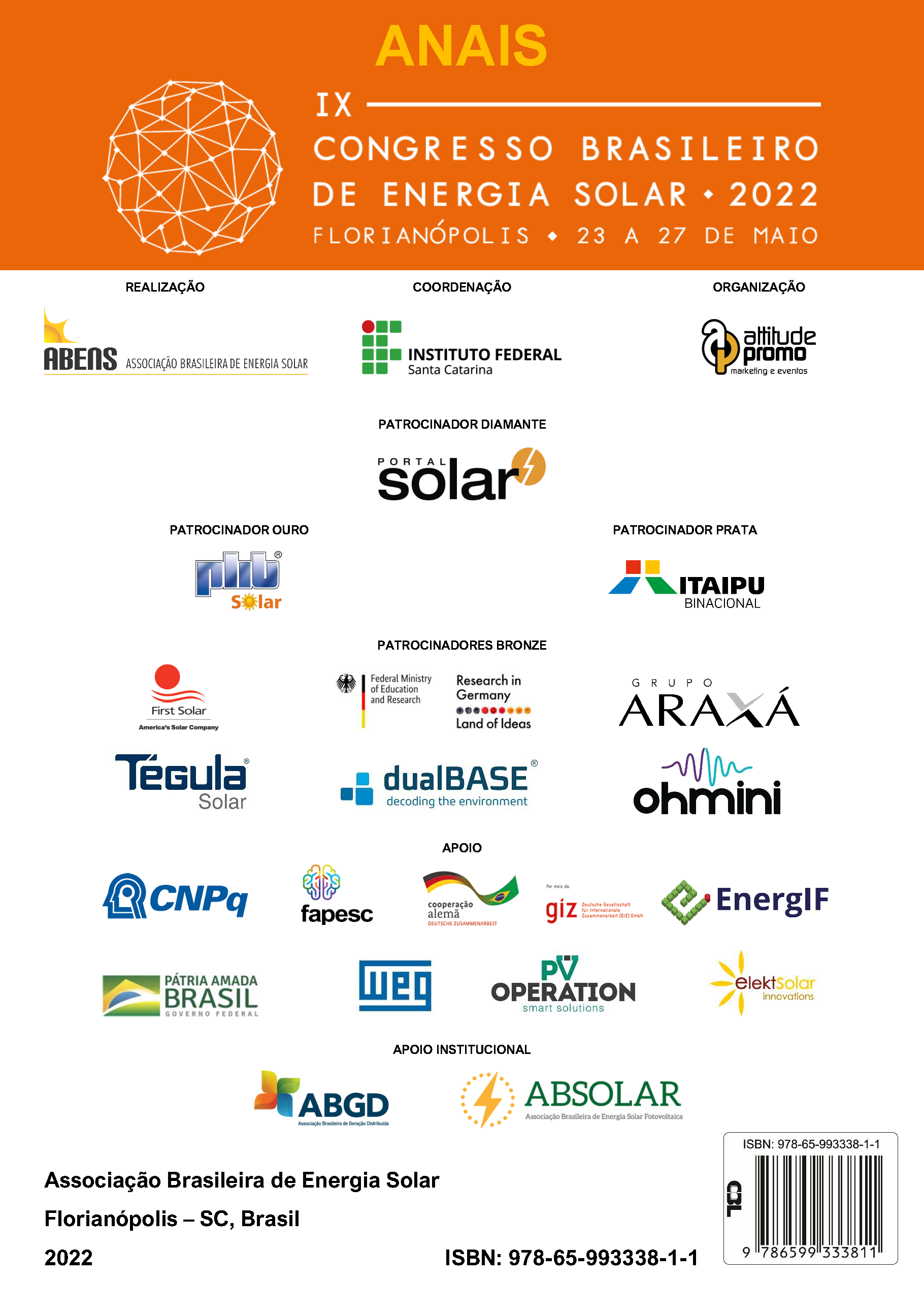AVALIAÇÃO DE ESTRATÉGIAS PASSIVAS PARA AUMENTO DA PENETRAÇÃO DA GERAÇÃO SOLAR FOTOVOLTAICA EM MINIRREDES HÍBRIDAS FV+DIESEL
DOI:
https://doi.org/10.59627/cbens.2022.1165Palavras-chave:
Amazônia, Sistemas Isolados, Aumento de penetração fotovoltaicaResumo
O Brasil possui o maior sistema integrado de energia do mundo controlado por um operador centralizado, porém o norte brasileiro possui dificuldades geográficas de conexão na nessa rede centralizada. O país ainda possui 212 sistemas isolados, formando o denominado SISOL. Segundo a literatura, a penetração típica de geradores FV em sistemas isolados não automatizados varia de 10% a 20%; contudo, existem estratégias passivas que podem ser utilizadas em sistemas isolados não automatizados que buscam reduzir a variabilidade instantânea da energia solar, possibilitando o aumento na máxima penetração FV. Neste trabalho, são analisados os efeitos de quatro estratégias passivas para aumentar o nível máximo de penetração FV. Os resultados mostraram que, a divisão de potência do grupo gerador Diesel em múltiplos geradores proporcionaria penetração máxima FV de 21%; a dispersão geográfica dos sistemas FV proporcionaria penetração máxima FV de 30%; o uso de rastreadores de um eixo nos sistemas FV proporcionaria penetração FV máxima de 21% e o sobrecarregamento dos inversores FV proporcionaria penetração FV máxima de 24%.
Downloads
Referências
ASENSIO, Miguel e CONTRERAS, Javier. Impact of demand response in an isolated system with high PV penetration. Set 2014, [S.l.]: IEEE, Set 2014. p. 1–6. Disponível em: <http://ieeexplore.ieee.org/document/6934605/>.
KLIMA, Kelly e APT, Jay. Geographic smoothing of solar PV: Results from Gujarat. Environmental Research Letters, v. 10, n. 10, 2015.
LAVE, Matthew e STEIN, Joshua S. e ELLIS, Abraham. Analyzing and simulating the reduction in PV powerplant variability due to geographic smoothing in Ota City, Japan and Alamosa, CO. Conference Record of the IEEE Photovoltaic Specialists Conference, v. 2, n. PART 2, 2012.
MARCOS, Javier e colab. Smoothing of PV power fluctuations bygeographical dispersion. PROGRESS IN PHOTOVOLTAICS: RESEARCH AND APPLICATIONS, v. 20, n. 6, p. 226–237, 2012.
MURATA, Akinobu e YAMAGUCHI, Hiroshi e OTANI, Kenji. A method of estimating the output fluctuation of many photovoltaic power generation systems dispersed in a wide area. Electrical Engineering in Japan (English translation of Denki Gakkai Ronbunshi), v. 166, n. 4, p. 9–19, 2009.
RIBEIRO, Luiz A.de S. e colab. Making isolated renewable energy systems more reliable. Renewable Energy, v. 45, p. 221–231, 2012.
RÜTHER, Ricardo e colab. Cutting on Diesel, boosting PV: The potential of hybrid Diesel/PV systems in existing mini-grids in the Brazilian Amazon. Proceedings of the 3rd World Conference on Photovoltaic Energy Conversion, v. C, p. 2620–2623, 2003.
SANTIAGO, Isabel e colab. Influence of photovoltaic installation angles and geographical dispersion in the smoothing of photovoltaic fleet power fluctuations. EEEIC 2016 - International Conference on Environment and Electrical Engineering, 2016.
SHIVASHANKAR, S. e colab. Mitigating methods of power fluctuation of photovoltaic (PV) sources - A review. Renewable and Sustainable Energy Reviews, v. 59, p. 1170–1184, 2016. Disponível em: <http://dx.doi.org/10.1016/j.rser.2016.01.059>.
VERÍSSIMO, Pedro Henrique Alves e colab. Area and LCOE considerations in utility-scale, single-axis tracking PV power plant topology optimization. Solar Energy, v. 211, n. July, p. 433–445, 2020.
WEIGL, Toni e colab. Modelling and validation of spatial irradiance characteristics for localised irraddiance fluctuations and enhancements. Proc. of PVSEC 2012, p. 3801–3804, 2012.


